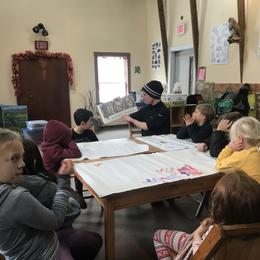Each Fall when I was a child, my father and I drove up to Vermont for a long weekend. We would hike, press apples into cider, and get up early every morning to look for moose. Having grown up in a suburb of Boston, I saw Vermont as a boundless wilderness and eagerly awaited trips to the state. Running through autumnal forests, exploring frosted fields, and harvesting fresh food was always preferable to homework and routine.
Looking back, I recognize that this extensive time exploring nature was integral to my development. Indeed, volumes of research have been produced that show exactly this: nature is as important to childhood growth as adequate sleep and good nutrition. Despite this fact, today’s youth are largely separated from the natural world due to the increasing pressures of school and the distraction of technology. I’ve noticed this increasing separation between children and nature while watching my own young relatives grow up. Thus, I was thrilled to have the opportunity to spend the fall season as an education intern at Audubon Vermont and help introduce a new generation of young people to the wild.
Audubon Vermont’s Huntington property spans 255 acres and a variety of habitats and is a prime location for the numerous school groups that visit each fall. On the first day of my internship, I was exposed to two vastly different programs put on at Audubon Vermont. I shadowed naturalists Emily and Sarah as they taught preschool students “Critter Constriction,” a day structured around teaching preschool students about the ways in which animals make their homes. At the Beaver Pond, an eager child was dressed up as a beaver to allow his classmates to learn about the physical adaptations needed to survive in an aquatic environment. Meanwhile, another group of students learned to identify and construct bird nests in the heart of the sugarbush. After two hours, everyone left with a greater appreciation for the variety of ways in which Vermont’s native animals make a living in what can be a harsh environment.
I ended my first day as an intern by spending two hours in the sugarbush and by the Beaver Pond with an after-school group. Unlike the structured Critter Constructions program, these kids were here to explore the outdoors and release some energy after a long and sedentary day at school. Without the distraction of phones and computers, and free from the confines of the classroom, our after-school friends found themselves playing games in the brush, climbing trees, making see-saws out of logs, and losing themselves in the outdoors.
My time at Audubon progressed quickly after this first day. I transitioned from shadowing programs to leading them, and I saw Audubon’s operations from a variety of angles. I led programs on birds, autumn, trees, and turkeys. I led preschoolers on hikes and helped homeschoolers earn merit badges. Alongside Sarah, Audubon’s AmeriCorps member, I tabled at the Youth Environmental Summit in Barre, Vermont and helped middle and high school students make packets of native seeds to plant in their yards. On the Monday and Tuesday preceding Thanksgiving, I helped run an all-day vacation camp. Using all the skills I had gained over the previous two months, I led kids as they played games, hiked, cast animal tracks, and made peanut-butter bird feeders. Through all of this, I increased my knowledge of natural history, my confidence in leading groups, and helped to connect hundreds of local students to the land in which they live.
Audubon Vermont is special because it provides a space where children can spend a day building forts in a forest, looking for amphibians in a pond, or simply playing games outside with their friends. While time spent here may be a small part of their overall lives, they will grow up with memories of the outdoors and knowledge of a world far greater than anything found in a home or school. In my experience, the more time a person spends in the wild, the more it becomes part of them. This drives one to spend a lifetime outside, engaged in adventure and friendship. It compels one to defend the wild and join the long legacy of American conservation defenders. It allows one to truly know the planet they call home. I’m deeply grateful to have had the opportunity to spend the season with Audubon and everyone who visited it, becoming a small part of a 50 year journey connecting people and nature in the heart of the Green Mountains.




